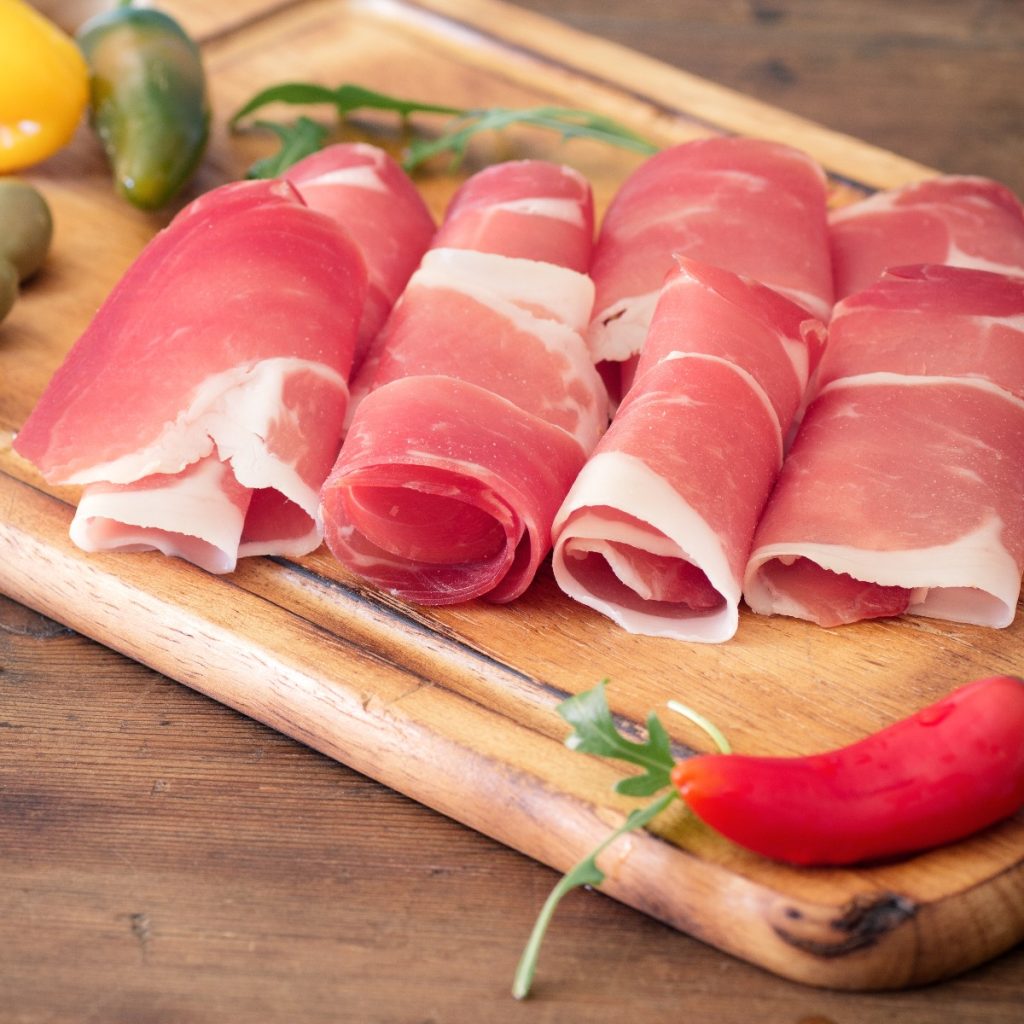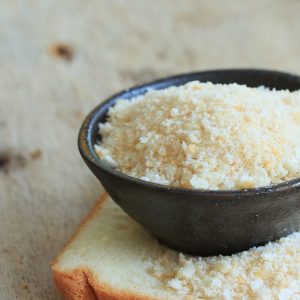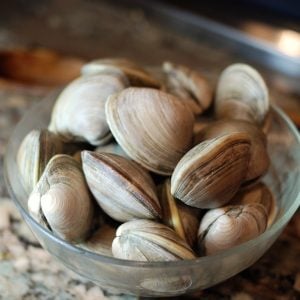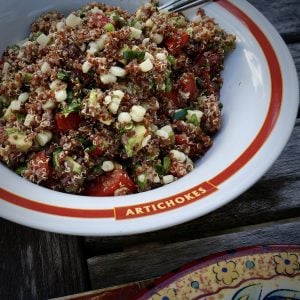Prosciutto Demystified: Types, Uses & Why It Costs So Much
Prosciutto brings an unmistakable touch of elegance to any dish. Though I don’t eat it often, I’m never disappointed when I do.
This Italian dry-cured ham has earned worldwide fame for its delicate texture, rich flavor, and deeply aromatic qualities. Unlike pancetta or guanciale, which are often cooked into dishes, prosciutto is typically enjoyed in its raw, paper-thin form.
The process of making prosciutto is as much an art as a craft. Producers carefully salt and air-dry the hind leg of a pig, allowing it to cure over many months, sometimes even years.
As the meat loses moisture and absorbs the subtle influence of salt and air, its flavor intensifies and its texture becomes beautifully tender. The result is a luxurious ingredient that elevates whatever it touches.
You’ll find prosciutto draped over fresh melon, layered into pasta, topping crisp pizza, or served as a simple appetizer with cheese and olives. While it can be a splurge, a little prosciutto goes a long way.
Whether you’re adding it to a weekday meal or a special gathering, prosciutto rewards you with incredible depth of flavor and a true taste of Italian tradition.
Types of Prosciutto
Who knew there are so many different types of prosciutto, with their unique flavor and production method? Some of the most popular types of prosciutto include:
Prosciutto | Origin | Description |
| Prosciutto di Parma (PDO) | Parma, Emilia-Romagna, Italy | The most famous variety, aged at least 12 months. Sweet, nutty, delicate flavor with melt-in-your-mouth texture. Made with pork and sea salt only. |
| Prosciutto di San Daniele (PDO) | San Daniele del Friuli, Friuli Venezia Giulia, Italy | Aged at least 13 months. Slightly darker and sweeter than Parma prosciutto, with a soft, silky texture. |
| Prosciutto Toscano (PDO) | Tuscany, Italy | Heavily spiced with pepper, garlic, and local herbs. More savory and robust, with a firmer texture. |
| Prosciutto di Modena (PDO) | Modena, Emilia-Romagna, Italy | Balanced flavor with subtle sweetness and aroma. Typically aged 14-16 months; less salty than other varieties. |
| Prosciutto di Carpegna (PDO) | Carpegna, Marche, Italy | Delicate, aromatic, with a gentle sweetness. Produced in small quantities; air-dried in mountain climate. Aged at least 13 months. |
| Prosciutto di Cinta Senese (PDO) | Siena, Tuscany, Italy | Made from heritage Cinta Senese pigs. Rich, complex flavor with pronounced marbling and a deep, savory taste. Rare and prized. |
| Prosciutto di Norcia (PGI) | Norcia, Umbria, Italy | Rustic, hearty flavor with a distinct mountain-air cured character. Often aged longer for an intense, traditional taste. |
Many other types of prosciutto are made in different regions of Italy and other countries as well. Each type has its unique flavor and character, and all are beloved by prosciutto lovers worldwide.
Ways to Cook with Prosciutto
Prosciutto is a versatile ingredient used in many different ways in cooking. Here are some of the most popular ways to use prosciutto in the kitchen:
Dish | Description |
| Appetizers | Thin slices served alone or wrapped around melon, figs, or asparagus. Elegant and simple starters that highlight prosciutto’s delicate flavor. |
| Charcuterie Board | Featured alongside cheeses, olives, nuts, and fruits for a balanced platter highlighting prosciutto’s delicate, salty notes. |
| Crostini | Placed atop toasted bread with spreads like ricotta, fig jam, or pesto for a quick, tasty bite. |
| Frittatas | Mixed into beaten eggs with herbs, cheese, and veggies, providing bursts of savory, cured meat flavor throughout the frittata. |
| Omelets | Added to omelets with cheese and herbs, providing a salty contrast to the fluffy eggs. |
| Pasta | Tossed into warm pasta dishes like carbonara or creamy sauces, prosciutto adds depth and a savory, slightly smoky note. Also great in cold pasta salads. |
| Pizza | Added after baking or just before finishing, prosciutto adds a salty, savory contrast to melted cheese and tomato sauce. Works well with arugula or burrata toppings. |
| Quiche | Incorporated into egg custards with cheese and vegetables, prosciutto imparts a rich, salty flavor that elevates the dish. |
| Risotto | Stirred into creamy risotto to add a savory, meaty depth that complements the richness of the rice. |
| Salads | Draped over fresh greens, paired with cheeses like mozzarella or Parmesan, nuts, and vinaigrettes for a flavorful, protein-rich salad. |
| Sandwiches | Layered with fresh mozzarella, tomatoes, or roasted vegetables on crusty bread or ciabatta, creating a sophisticated and flavorful sandwich. |
| Stuffed Vegetables | Used as a flavorful wrapping or mixed into fillings for stuffed peppers, mushrooms, or zucchini boats. |
| Wraps | Wrapped around cheese sticks, breadsticks, or vegetables like asparagus for an easy, elegant finger food. |
What’s In a Name?
The word “prosciutto” comes from the Italian word “prosciugare,” which means “to dry.” This is fitting, as the key to prosciutto’s distinctive taste and texture is the slow, patient drying process.
Traditionally, prosciutto was produced in the northern Italian regions of Parma, San Daniele, and Modena. Still, it is now made in other parts of Italy and many other countries.
Prosciutto is typically served in thin slices as an appetizer or antipasto, either on its own or with other cured meats, cheeses, or olives. It is also a popular ingredient in many Italian dishes, such as pasta, pizza, and risotto, adding a salty, savory flavor to these dishes.
There are two main types of prosciutto: prosciutto crudo (raw) and prosciutto cotto (cooked). Prosciutto crudo is the more traditional type, made from a dry-curing process. In contrast, prosciutto cotto is cooked and often used as a substitute for ham in sandwiches and other dishes.
Prosciutto is a beloved delicacy that people have enjoyed for centuries. Its rich flavor and tender texture make it a versatile ingredient in many recipes, and its long history and traditional production methods give it a unique and authentic character.
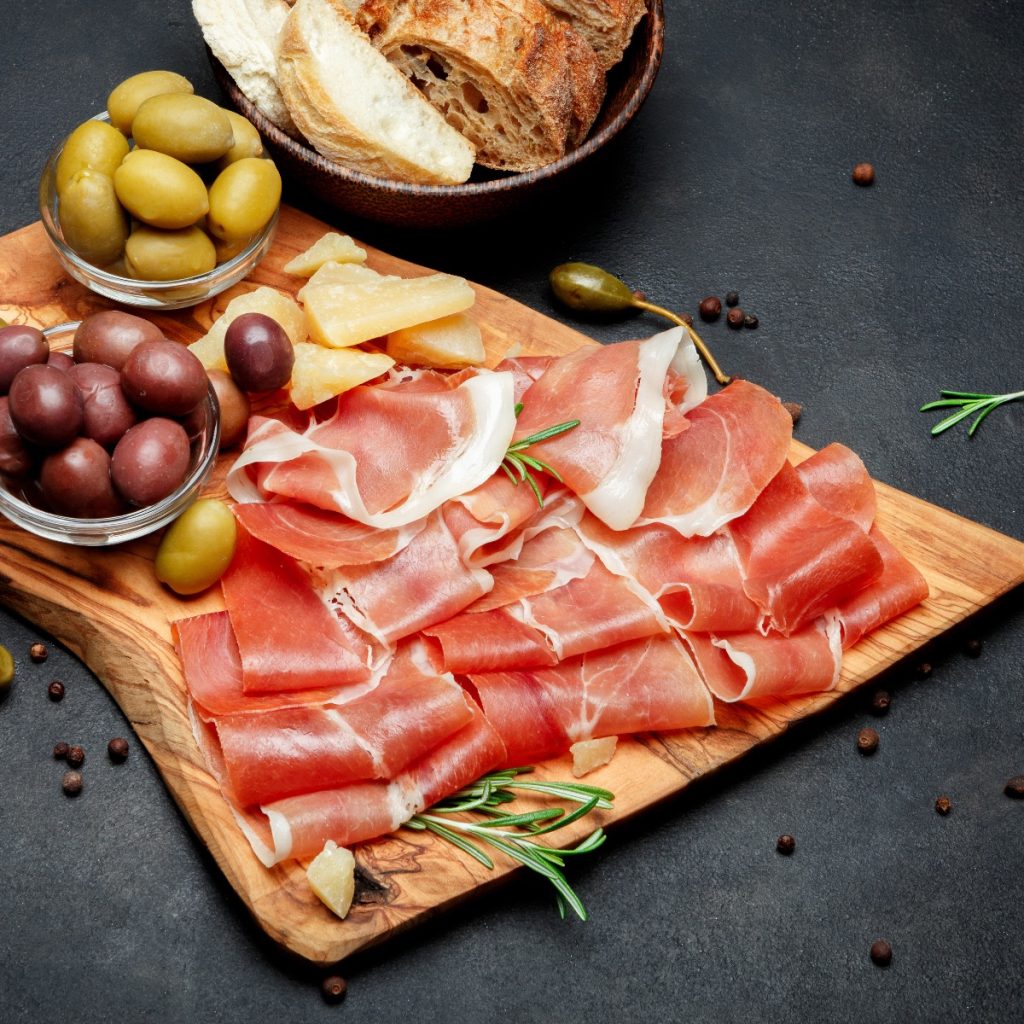
Why Is It So Expensive?
Time and Labor-Intensive Production Process
Production is labor-intensive and takes much time and care. The meat needs to be carefully selected and prepared, and it then needs to be salted and cured for an extended period. The entire process can take anywhere from 12 to 36 months, depending on the type. The long curing time and the attention to detail required during production contribute to the high cost.
High-Quality Ingredients
The quality of the ingredients used to make it also contributes to its high cost. The best prosciutto is made from specially-raised pigs that are fed a specific diet and are free from antibiotics and hormones. The pigs must be raised in a specific region of Italy, and their meat must meet strict quality standards. The high cost of these high-quality ingredients is reflected in the price of prosciutto.
Limited Production
Produced in limited quantities, which drives up the price. It is only made in some areas of Italy and other countries where the climate and other conditions are suitable for curing the meat. Additionally, only a certain number of pigs are used to make prosciutto each year, which limits the supply and contributes to the high cost.
High Demand
Prosciutto is a popular delicacy worldwide, and its high demand also contributes to its high cost. Because it is a luxury item, people are willing to pay more, increasing the price.
Is Prosciutto Like Bacon?
Prosciutto and bacon are both types of cured pork, but they differ in flavor, texture, and preparation.
Bacon is typically made from pork belly and is heavily smoked, giving it a smoky, salty flavor. It is usually sliced thick and is often fried or baked before serving. Bacon is often used as a breakfast food but can also be used in sandwiches, salads, and other dishes.
Prosciutto, on the other hand, is made from the pig’s hind leg and is air-dried rather than smoked. As a result, it has a delicate, savory flavor that is not as salty as bacon. It is typically sliced very thin and is often served as an appetizer or used as a garnish for other dishes.
While bacon and prosciutto are types of cured pork, they are quite different in terms of flavor, texture, and usage. Bacon is generally used in dishes that require a strong smoky flavor, while prosciutto adds a delicate, savory flavor to a wide range of dishes.

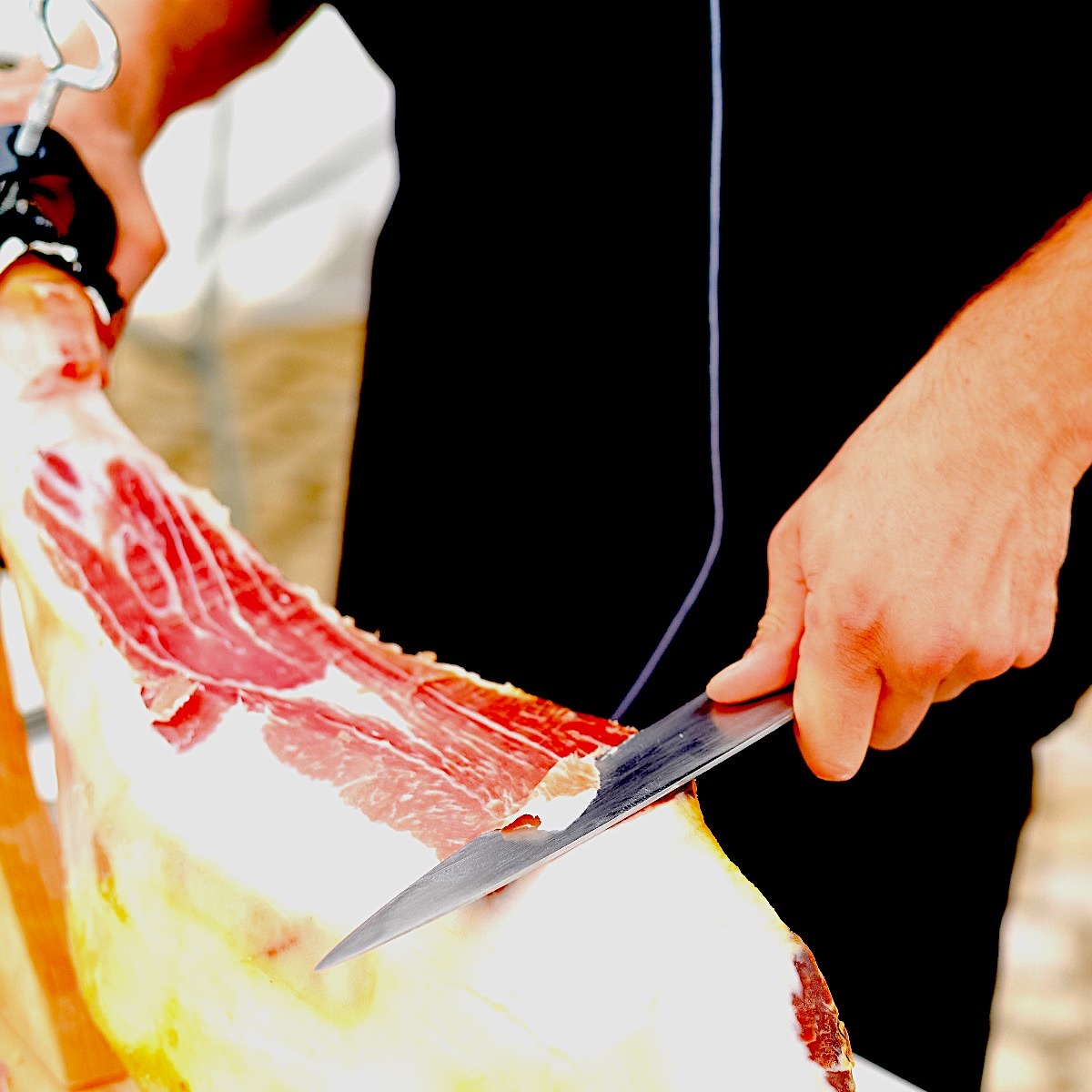
Where to Buy Prosciutto?
If you’re looking to buy prosciutto, there are several options available, depending on your location and preferences.
Specialty Stores
Specialty stores, such as Italian markets and gourmet food stores, are excellent places to start when looking for it. These stores often carry high-quality imported prosciutto from Italy and other regions and locally made varieties.
Online Retailers
Many online retailers specialize in selling high-quality food products, including prosciutto. When buying prosciutto online, read reviews and look for retailers with a good reputation for quality and customer service.
Supermarkets
Many supermarkets now carry prosciutto in their deli sections. While the quality of the prosciutto may vary, this can be a convenient and affordable option for buying prosciutto.
Farmer's Markets
If you have a local farmer’s market in your area, you may be able to find locally made prosciutto from small-scale producers. This can be an excellent way to support local businesses and get a unique, high-quality product.
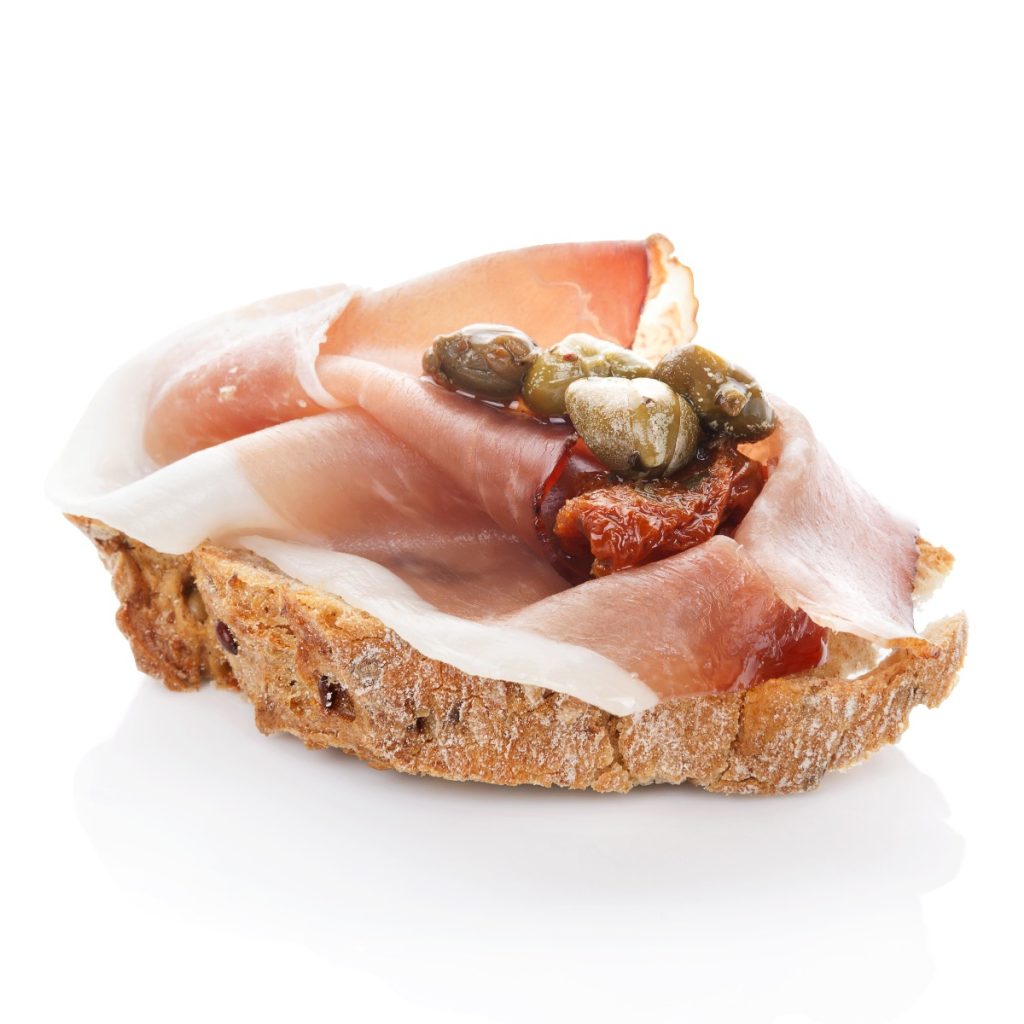
When purchasing prosciutto, it is essential to look for high-quality products made from the finest ingredients and properly cured. Reading reviews, researching reputable retailers, and seeking recommendations from friends or local food experts can help you find the best prosciutto for your needs.

